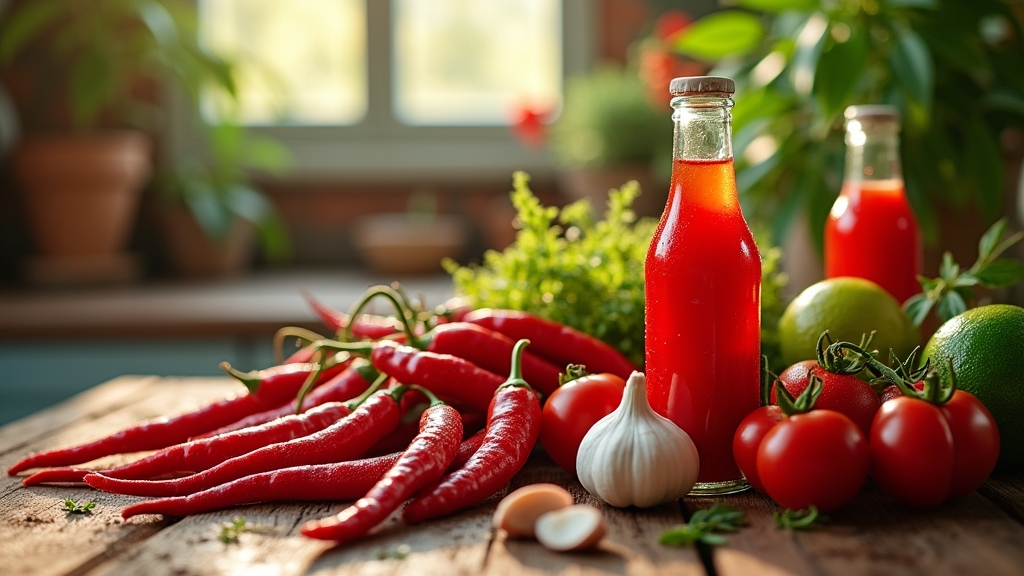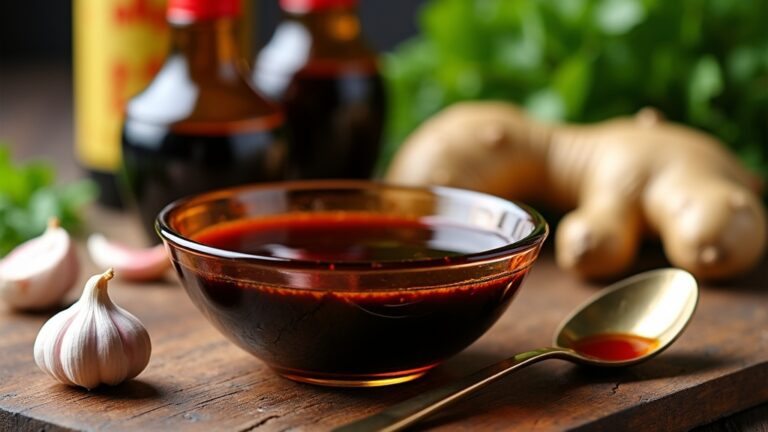Hot Sauce Recipe
I love making my own hot sauce at home! It’s all about choosing fresh chili peppers and blending them with garlic, vinegar, and salt. I simmer the mixture to let the flavors meld beautifully. Adjusting the heat level is part of the fun—I like starting mild and adding hotter peppers as I go. Once it’s bottled, it’s the perfect kick for tacos or grilled meats. Stick around, and I’ll share more tips and tricks for your hot sauce journey!
Contents
History
When I think about the history of hot sauce, I can’t help but be fascinated by its journey through cultures and time. This fiery condiment isn’t just about heat; it carries deep cultural significance across the globe. From the spicy salsas of Mexico to the tangy sambals of Southeast Asia, each region boasts unique flavors and ingredients that reflect their culinary heritage. I find it intriguing how hot sauce has evolved, adapting to local palates while maintaining its core essence. With countless regional variations, it’s not just a sauce; it’s a story of innovation, creativity, and tradition. Exploring these diverse interpretations connects us to the people and cultures behind each bottle, making every drop a reflection of shared experiences and taste.
Recipe
Hot sauce is a fiery condiment that can elevate any dish, from tacos to grilled meats, with its vibrant flavors and heat. Making your own hot sauce at home allows you to customize the heat level and flavor profile to suit your taste. Whether you prefer a smoky, tangy, or sweet sauce, the beauty of homemade hot sauce is that you can experiment with different types of peppers and additional ingredients to create the perfect blend.
Elevate your dishes with homemade hot sauce, tailored to your taste and bursting with vibrant flavors and heat.
To start your hot sauce journey, gather fresh ingredients and prepare to release your culinary creativity. This recipe provides a balanced mix of heat and flavor, making it a versatile addition to your kitchen. Once you’ve mastered the basics, you can always tweak the recipe to create your unique version that showcases your preferred heat level and flavor nuances.
Ingredients:
- 10 fresh chili peppers (such as jalapeños, habaneros, or serranos)
- 1 cup white vinegar
- 4 cloves garlic, minced
- 1 tablespoon salt
- 1 tablespoon sugar (optional)
- 1 tablespoon olive oil
- Juice of 1 lime
In a medium saucepan, combine the chopped chili peppers, minced garlic, vinegar, salt, sugar, and lime juice. Bring the mixture to a boil over medium heat, then reduce to low and simmer for about 10-15 minutes until the peppers are soft. Allow the mixture to cool slightly before transferring it to a blender. Blend until smooth, adjusting the thickness with a bit more vinegar if necessary. Pour the sauce into a sterilized bottle or jar, seal it, and refrigerate.
When making hot sauce, feel free to experiment with different types of peppers and their combinations to find the flavor that suits you best. Remember that the heat can vary greatly between pepper varieties, so taste as you go. Additionally, let the sauce sit for a few days in the refrigerator to allow the flavors to meld and develop. Homemade hot sauce can last for several weeks, but trust us, it won’t last long once you start using it!
Cooking Steps
To kick off our hot sauce adventure, I start by gathering fresh chili peppers that will bring the perfect heat to my recipe. Then, I blend the ingredients thoroughly to create a vibrant mixture that sings with flavor. After that, I simmer it all together, letting the spices mingle and create a sauce that’s uniquely mine.
Step 1. Gather Fresh Chili Peppers
Gathering fresh chili peppers is an exciting adventure that sets the foundation for a flavorful hot sauce. I love exploring local markets or my own garden, where I can find diverse fresh pepper varieties like jalapeños, habaneros, and serranos. Each type brings its unique heat and flavor profile, allowing for creative experimentation. When I pick peppers, I focus on their vibrant colors and firm texture, ensuring they’re ripe and bursting with flavor. If you’re growing your own, proper chili plant care is essential; I make sure they’re well-watered and receive plenty of sunlight. This careful selection process not only enhances the taste of my hot sauce but also connects me to the ingredients I’m using.
Step 2. Blend Ingredients Thoroughly
Once I’ve selected the freshest chili peppers, it’s time to blend the ingredients thoroughly to create that perfect hot sauce base. I start by tossing my peppers into the blender, along with garlic, vinegar, and a pinch of salt. Using various blending techniques, I pulse the mixture to achieve the desired consistency—smooth yet slightly chunky for texture. As I blend, I pay close attention to how the flavor profiles develop; the heat from the peppers combines beautifully with the tanginess of the vinegar, while the garlic adds depth. I experiment with blending speeds, ensuring all ingredients meld harmoniously. This stage is essential; it sets the foundation for the flavor explosion that will follow, so I embrace the artistry of blending!
Step 3. Simmer for Flavor Infusion
As I transfer the blended mixture into a saucepan, I can already envision the rich flavors that will unfold during the simmering process. This step is where the magic happens; as I gently heat the sauce, I’m coaxing out the deep, complex flavor profiles from each ingredient. I let it simmer on low heat, stirring occasionally, allowing the heat to meld everything together. It’s a simple yet powerful cooking technique that enhances the vibrant notes of the peppers while mellowing any harsh edges. The aroma fills my kitchen, hinting at the bold taste to come. I usually allow it to simmer for about 20-30 minutes, ensuring every layer of flavor has time to develop and shine.
Step 4. Bottle and Label Sauce
With the flavors beautifully melded and the sauce thickened to perfection, it’s time to bottle and label my creation. I carefully select a bottle design that not only showcases the vibrant color of the sauce but also feels good in my hand. I opt for a sleek, modern shape that stands out on any shelf. After pouring the sauce into the bottle with precision, I turn my attention to label printing. I craft a striking label that tells my sauce’s story—bold colors and enticing fonts draw the eye. I include essential details like ingredients and heat level, ensuring that my creation is both visually appealing and informative. Now, my hot sauce is ready to share with the world!
Step 5. Adjust Spice Level
When I’m perfecting my hot sauce, adjusting the spice level is essential to achieving that ideal balance of heat and flavor. I often refer to spice scales to guide my choices, ensuring I hit the right notes in my flavor profiles. Here’s how I fine-tune the heat:
- Start with a base: I use milder peppers to establish a foundation, allowing me to build complexity.
- Add heat gradually: By incorporating hotter varieties, like habaneros or ghost peppers, I can control the intensity without overwhelming the sauce.
- Test and tweak: I taste as I go, adjusting acidity and sweetness to complement the heat, ensuring every bite is a harmonious experience.
With these steps, I create a hot sauce that excites the palate without sacrificing flavor.
Nutritional Guide
Hot sauce packs a flavorful punch, but it’s also important to understand its nutritional profile. By diving into the ingredient breakdown, I’ve discovered some incredible nutritional benefits that can surprise you.
Here’s a quick look at what you’re adding to your meals:
| Ingredient | Nutritional Benefits | Calories per Serving |
|---|---|---|
| Chili Peppers | Boosts metabolism, rich in vitamins A and C | 20 |
| Vinegar | Lowers blood sugar levels | 3 |
| Garlic | Anti-inflammatory properties | 4 |
| Salt | Enhances flavor (use sparingly) | 0 |
| Sugar (optional) | Balances heat | 16 |
Understanding these elements can help you enjoy hot sauce while reaping its unique health advantages.
Final Thoughts
Starting on the journey of making your own hot sauce brings a sense of satisfaction and creativity to your cooking. It’s more than just a condiment; it’s an expression of your culinary identity. As you experiment with flavors and heat levels, you’ll discover unique combinations that tantalize your taste buds.
Consider these key aspects to enhance your hot sauce experience:
- Sauce Storage: Use glass bottles for longevity and to preserve flavors.
- Flavor Pairing: Explore pairing your sauce with dishes like grilled meats, tacos, or stir-fries for a delightful kick.
- Personal Touch: Don’t hesitate to adjust recipes to reflect your taste preferences!
Embrace the innovation of creating something truly your own. Happy saucing!
Frequently Asked Questions
Can I Use Different Types of Peppers in the Recipe?
I love experimenting with different pepper varieties. Each type brings unique flavor profiles, enhancing the overall taste. Mixing them not only sparks creativity but also elevates the dish to a whole new level of deliciousness.
How Long Does Homemade Hot Sauce Last?
Homemade sauces can last weeks in the fridge, months in the freezer. For ideal shelf life, I store mine in airtight containers, keep it cool, and label it—simple storage tips guarantee I enjoy my creation longer!
Can I Adjust the Spiciness Level?
I love making spice adjustments to achieve the perfect heat balance. By adding milder peppers or vinegar, I can dial down the heat, or mix in hotter varieties for an exciting kick. Enjoy experimenting!
Is Hot Sauce Gluten-Free?
When it comes to hot sauce, I always say, “the proof is in the pudding.” Most sauces are gluten-free, but I double-check the ingredients for hidden gluten sources. Always read labels to stay safe!
What Are Some Creative Uses for Hot Sauce?
I love using hot sauce as a spicy marinade for grilled meats and veggies. It’s a fantastic flavor enhancer, too! Drizzling it on popcorn or mixing it into dressings adds a delicious kick to any dish.
Conclusion
In crafting your own hot sauce, you’re not just mixing ingredients; you’re creating a culinary masterpiece that bursts with bold flavors. Each batch tells a story, blending tradition and taste in every tantalizing drop. So, don’t shy away from experimentation—embrace the exciting exploration of spice! With a dash of daring and a sprinkle of passion, your homemade hot sauce will surely ignite imaginations and elevate everyday meals. Get saucy, and savor the sensational!

